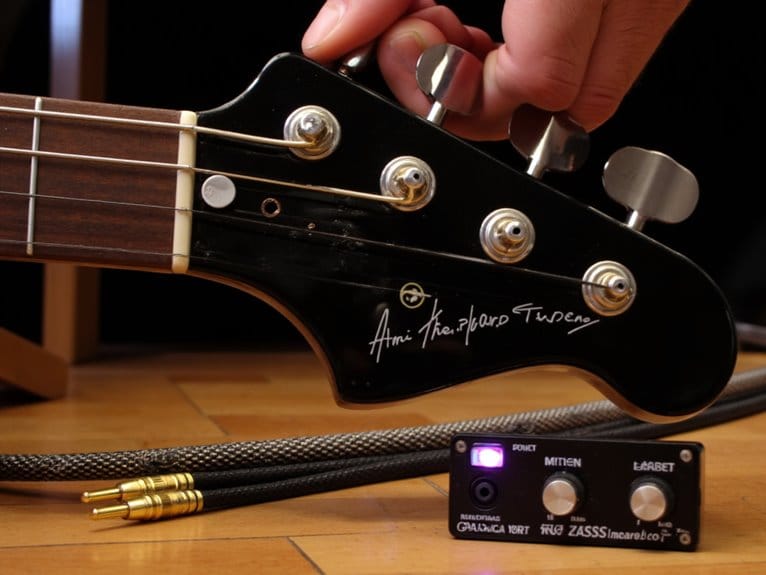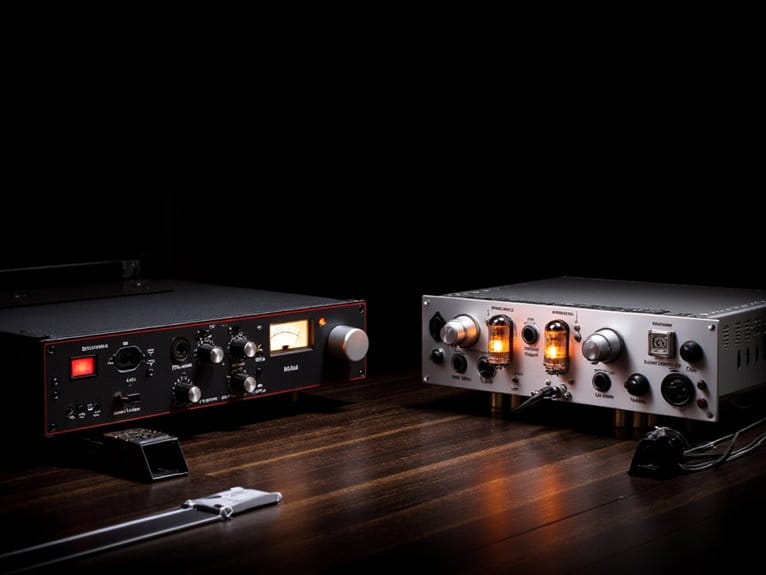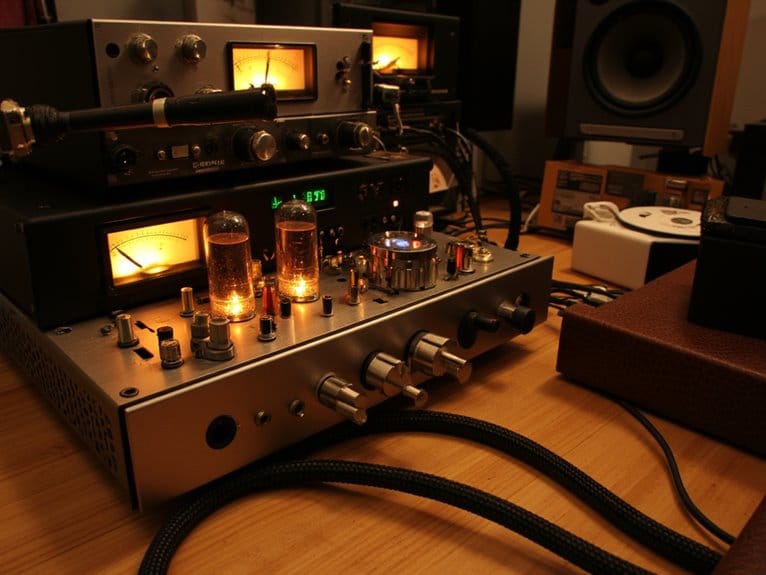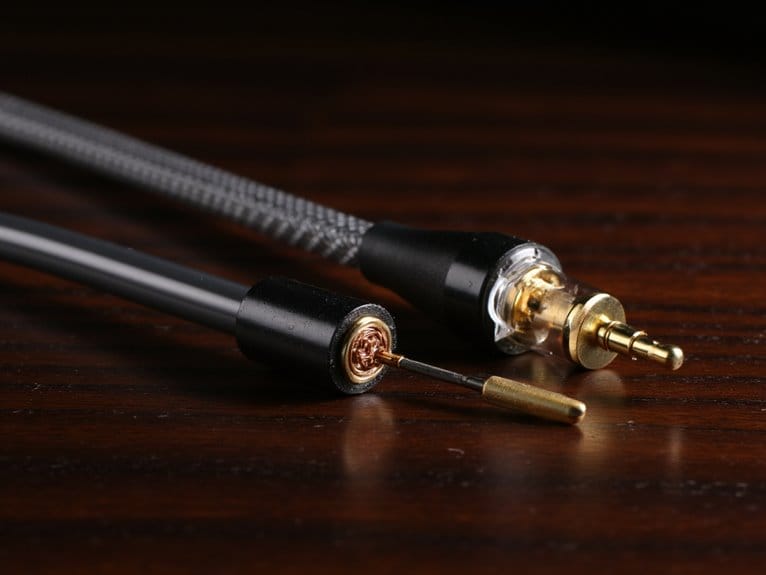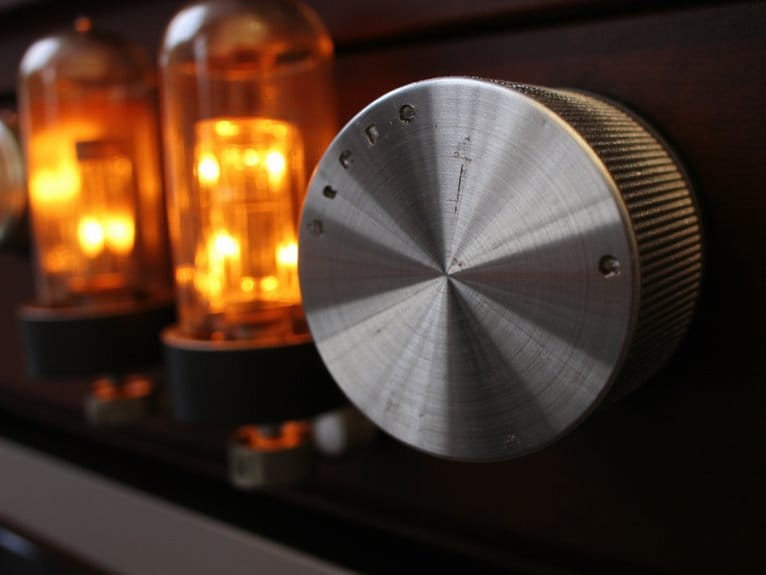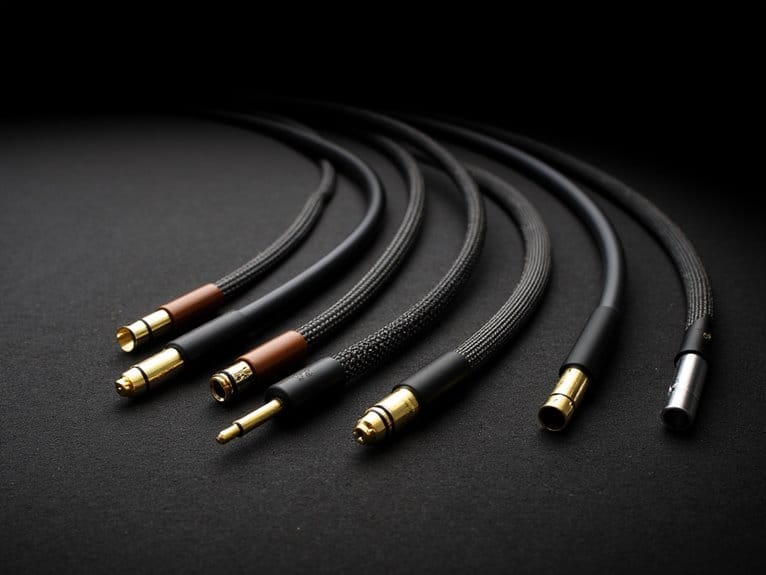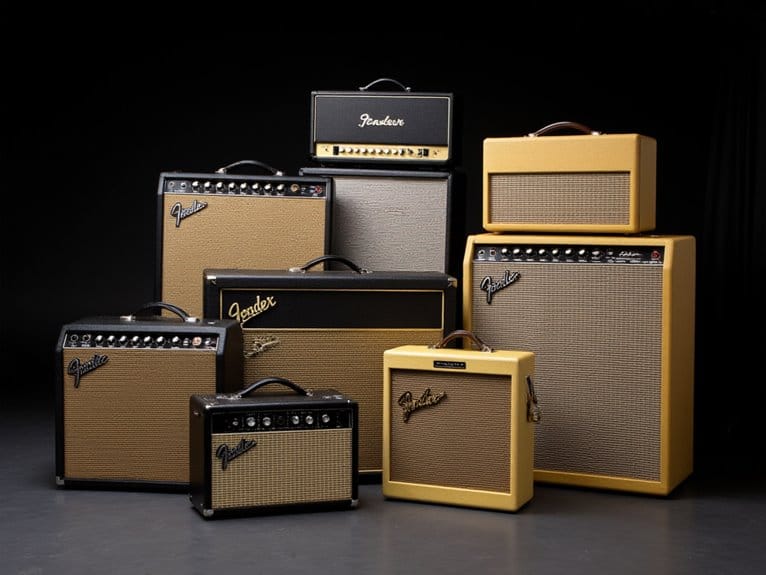How to Eliminate Bass Guitar Noise and Interference
You can eliminate bass guitar noise by mastering proper muting techniques with your plucking fingers, installing copper shielding in control cavities to block electromagnetic interference, and ensuring proper bridge grounding connections. Address fret buzz through neck relief adjustments in quarter-turn increments, optimize your signal chain with tuners first and noise suppressors last, and maintain clean strings using microfiber cloths regularly. These foundational steps will greatly improve your tone clarity and prepare you for advanced noise reduction strategies.
We are supported by our audience. When you purchase through links on our site, we may earn an affiliate commission, at no extra cost for you. Learn more.
Notable Insights
- Use proper muting techniques and the “pull across” method to suppress unwanted string noise during playing.
- Adjust neck relief and action height in quarter-turn increments to eliminate fret buzz and mechanical noise.
- Install copper shielding in control cavities and ensure proper bridge grounding to block electromagnetic interference.
- Arrange pedals correctly with tuner first, filters and compressors next, then distortion, and noise suppressors last.
- Clean strings regularly with microfiber cloth and use string lubrication products to reduce finger noise.
Mastering Muting and String Control Techniques
When I first started playing bass, I thought unwanted string noise was just something you’d have to live with, but mastering proper muting and string control techniques can eliminate nearly all of that distracting buzz and ring that plagues many players.
Proper muting techniques transform bass playing from noisy and amateur to clean and professional with coordinated hand control.
The key lies in coordinating both hands to control string resonance effectively, using your plucking hand thumb as an anchor on adjacent strings while implementing finger damping with your fretting hand.
I’ve found that the “pull across” technique, where your plucking finger slightly contacts neighboring strings, works remarkably well for immediate noise suppression. This approach helps create the clean sound that controls unwanted vibrations, much like the techniques used by masters such as Gary Willis and Victor Wooten.
Combine this with rest strokes and strategic finger placement, and you’ll achieve the clean, professional sound that separates amateur players from seasoned bassists. Using the fleshy part of your plucking finger rather than the tip produces warmer tone while maintaining precise string control.
Your choice of pick material can also influence string control, as heavy gauge picks provide better precision and reduced unwanted string vibrations during aggressive playing styles.
Electrical Grounding and Shielding Solutions
While proper technique eliminates mechanical noise, electrical interference requires a completely different approach that involves creating proper grounding pathways and electromagnetic shielding throughout your bass guitar’s electronics.
Bridge grounding forms the foundation of any effective noise reduction system, requiring you to solder a ground wire from your bridge to the common ground point, typically located at the back of a potentiometer. This establishes the main electrical return path that’s vital for reducing hum and static.
Copper shielding takes protection further by creating a Faraday cage effect inside your control cavities and pickup routes. You’ll need to line these areas with conductive copper foil tape, then connect the shielding to your circuit ground, effectively blocking electromagnetic interference and radio-frequency noise that causes that annoying “sizzle” sound. Passive single coil pickups are particularly susceptible to interference and benefit most from comprehensive shielding modifications.
Addressing Fret Buzz and Mechanical Issues
Although electrical interference can wreak havoc on your bass tone, mechanical issues like fret buzz create an entirely different category of noise that stems from physical contact between strings and frets. This requires precise adjustments to your instrument’s setup rather than electronic solutions.
I’ve found that improper neck relief, typically caused by an overly straight or back-bowed neck, eliminates the slight concave curve necessary for clean string vibration. When you’re adjusting the truss rod, make quarter-turn increments and wait between adjustments, as rushing this process can damage your neck permanently.
If uneven frets persist after setup adjustments, professional fret leveling becomes essential, since worn or inconsistent fret heights create localized buzzing that no amount of action adjustment will eliminate completely.
Optimizing Equipment and Signal Chain Setup
Beyond addressing mechanical issues, I’ve discovered that optimizing your signal chain represents perhaps the most critical factor in achieving pristine bass tone, since every component from your first pedal to your amplifier’s input either preserves or degrades your instrument’s natural voice.
Equipment optimization starts with proper pedal order: tuner first, followed by filters, compressors, then distortion effects, with noise suppressors positioned last to clean high-gain artifacts.
I’ve learned that strategic buffer placement at chain endpoints counteracts signal loss, while quality shielded cables minimize electromagnetic interference that plagues longer runs.
Proper gain staging prevents clipping, and thoughtful compressor placement—either early for signal normalization or late for overall “glue”—dramatically reduces cumulative noise buildup throughout your entire rig.
Managing Environmental and External Interference
The moment you’ve optimized your signal chain and addressed mechanical issues, you’ll quickly discover that your bass exists within an electromagnetic minefield of environmental interference sources that can sabotage even the most carefully crafted setup.
Fluorescent lighting, computer monitors, and air conditioning units constantly emit radio frequency noise that passive pickups enthusiastically collect. I’ve learned that positioning strategies matter tremendously—keeping your bass away from these culprits while orienting yourself perpendicular to interference sources reduces pickup susceptibility.
Cable quality becomes your first line of defense, with well-shielded cables around forty dollars providing dramatically better protection than budget alternatives. When recording, connecting through an audio interface provides additional signal conditioning and isolation from electromagnetic interference that can plague direct connections to recording equipment. Professional recording setups benefit from zero-latency monitoring capabilities that eliminate timing delays while maintaining clean signal paths.
Implementing proper shielding techniques, including ferrite core beads and ensuring solid grounding connections, transforms your bass from an antenna into a focused musical instrument. Look for cables featuring dual shielding designs and oxygen-free copper conductors to maximize electromagnetic interference rejection and maintain clean signal transmission.
Essential Instrument Setup and Maintenance Practices
Beyond addressing external interference, you’ll need to focus on your bass guitar’s internal setup and maintenance practices, which I’ve found can make or break your quest for clean, noise-free performance.
Proper string height adjustment, maintaining solid electronics and grounding connections, and implementing consistent cleaning routines form the foundation of a well-behaved instrument that won’t fight against you during recording or live performance.
These three core maintenance areas work together to eliminate the most common sources of unwanted noise that plague bass players, from fret buzz and electronic hum to the subtle crackling sounds that accumulate over time. Installing active pickups can provide enhanced noise reduction capabilities while delivering higher output levels compared to traditional passive systems.
String material choice also plays a crucial role in noise reduction, as stainless steel strings tend to produce cleaner electrical signals with less interference compared to other materials.
A quality bass preamp can significantly improve your signal clarity and reduce noise, especially when working with passive basses that may be more susceptible to interference.
String Height Adjustment
When I first started adjusting string height on bass guitars, I quickly learned that proper action setup isn’t just about comfort—it’s one of the most effective ways to eliminate unwanted noise and interference that can plague your signal chain.
String height directly controls fret buzz, sympathetic vibrations, and mechanical noise that muddy your tone, while proper measurement techniques guarantee consistent results across all strings.
You’ll want to measure at the 12th fret using a string action gauge, employing a capo on the first fret to eliminate neck relief variables.
Adjust each bridge saddle individually, starting with your highest string and working progressively toward the lowest, maintaining proper tension balance throughout the process.
Similar to how spring tension adjustments on drum pedals can eliminate mechanical inconsistencies and improve responsiveness, proper string height calibration removes physical impediments that interfere with clean signal transmission.
Even with perfect string height, residual electronic noise may require additional signal processing through a built-in noise gate to achieve truly pristine bass tones in professional recording environments.
For musicians who rely on overdrive effects, maintaining proper string height becomes even more critical since transparent overdrive pedals preserve your instrument’s natural character and will amplify any mechanical inconsistencies in your setup.
- Excessive string height creates unwanted sympathetic vibrations that cloud your mix
- Improper action wastes your practice time fighting against poor setup choices
- Precise adjustments transform frustrating buzz into pristine, professional-sounding performance
Electronics and Grounding
After countless hours troubleshooting hum, buzz, and interference issues in my workshop, I’ve discovered that proper electronics and grounding form the backbone of any truly quiet bass guitar setup.
The most effective grounding methods center around star grounding systems, where you’ll connect all ground points to a single central location, typically your volume pot casing, which eliminates problematic ground loops that amplify electronic noise.
You’ll want to shield your control cavity with copper foil or conductive paint, creating a Faraday cage that blocks electromagnetic interference from reaching your circuits.
Don’t forget your bridge ground wire—it’s essential for discharging static electricity and preventing string vibrations from inducing unwanted noise into your signal chain.
Similar to how Bluetooth speakers use DSP technology to minimize distortion and enhance audio clarity, modern bass guitars can benefit from digital signal processing units that actively filter out unwanted frequencies and electromagnetic interference.
Regular Cleaning Maintenance
Three decades of maintaining bass guitars has taught me that consistent cleaning maintenance forms the foundation of noise prevention, though I’ll admit I learned this lesson the hard way after countless gigs plagued by crackling strings and mysterious electrical interference.
Your cleaning routine should target three primary areas: strings, fretboard, and body. I recommend wiping strings with a microfiber cloth before and after playing, removing oils and grime that create unwanted noise.
Fretboard cleaning requires specialized conditioners containing lemon oil, applied during string changes for thorough access. String lubrication with products like String Fuel reduces finger noise while extending string life.
When not actively playing, store your bass on a guitar stand with protective padding to prevent dust accumulation and maintain the cleanliness of your instrument between sessions. Many bass players also benefit from connecting to a practice amplifier with headphone output capabilities for silent rehearsal sessions that won’t disturb others while maintaining proper technique. Using headphones with circumaural design provides better noise isolation, allowing you to focus on detecting subtle string noises and technique issues during practice.
- Dirty strings produce crackling sounds that ruin your tone during critical performances.
- Neglected fretboards develop grime buildup that creates buzzing and dead spots.
- Poor maintenance habits lead to costly repairs and embarrassing equipment failures.
Frequently Asked Questions
Can Different String Gauges Impact the Amount of Fret Buzz Produced?
Yes, different string gauges directly impact fret buzz. Heavier gauges increase string tension, requiring more fret height clearance, while lighter gauges reduce tension but need proper setup adjustments to prevent buzzing against frets.
Should I Use Active or Passive Pickups to Minimize Noise Issues?
You should choose active pickups for better noise reduction since they’re designed with low-noise circuits that minimize interference. When considering pickup installation, active vs passive systems differ markedly in their electromagnetic noise handling capabilities.
How Often Should Bass Strings Be Replaced to Prevent Noise Problems?
You should replace bass strings every 3-4 months for ideal string lifespan, though weekly changes suit professional recordings. Follow maintenance tips like regular cleaning with alcohol and wiping strings after playing to extend freshness.
On a final note
You’ve now got the complete toolkit for eliminating bass guitar noise, from mastering your muting technique and addressing electrical interference to fixing mechanical issues and optimizing your signal chain. I’ve found that combining proper instrument maintenance with environmental awareness creates the cleanest possible sound. Remember, you don’t need to tackle everything at once—start with the most obvious culprits and work systematically through each potential source.

